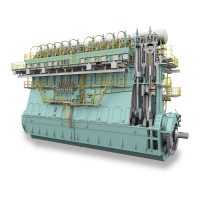Operation
4002−1/A1
Winterthur Gas & Diesel Ltd.
21/ 22
4.2.1 Remote Control System
The remote control system (RCS) has the primary functions that follow:
D Start, stop and reverse
D Automatic slow turning.
Data about the engine control system (ECS) status is available in the RCS. This
includes measured values of sensors, defects and other indications (see the
documentation of the remote control manufacturer).
All commands to operate the engine (e.g. AHEAD or ASTERN), come from the RCS.
If the ECS finds a defect, it sends a signal to the AMS, or a slowdown/shutdown
signal to the ESS.
4.2.2 LDU-20 − Engine Control Room
The LDU-20 in the engine control room (ECR) is part of the engine control
system (ECS) and installed in the ECR console. The same control functions of the
LDU-20 in the ECR are available at the local control panel (see also 4002−2 Local
Control Panel/Local Display Unit LDU-20, paragraph 2).
4.2.3 Engine Safety System
The engine safety system (ESS) has the primary functions that follow:
D Emergency stop
D Overspeed protection
D Automatic shutdown
D Automatic slowdown.
If there is a defect, the engine control system (ECS) sends a signal to the ESS.
4.2.4 Telegraph System
The telegraph system transmits maneuvering signals from the bridge to the ECR and
local control panel.
4.3 Alarm and Monitoring System
The alarm and monitoring system (AMS) is an external system and monitors the
engine. The AMS gives the operator alarms and status data of the engine, to make
sure of a safe and efficient engine operation.
The functions of the AMS are specified in the DENIS. The AMS sends signals to the
engine safety system to slow down or shut down the engine (see Fig. 10)
For more data, see the documentation of the AMS manufacturer.
Engine Control System
2015-12

